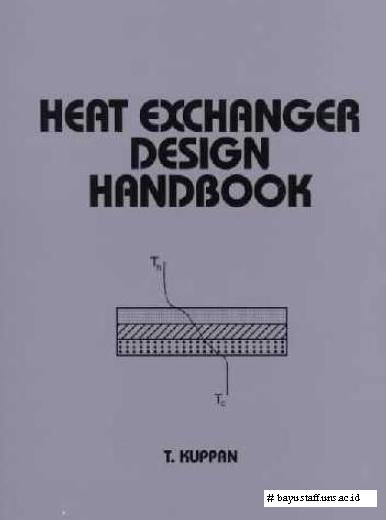Heat Exchanger Design

Preface
1. Heat Exchangers-Introduction, Classification, and Selection
2. Heat Exchanger Thermohydraulic Fundamentals
3. Heat Exchanger Thermal Design
4. Compact Heat Exchangers
5. Shell and Tube Heat Exchanger Design
6. Regenerators
7. Plate Heat Exchangers and Spiral Plate Heat Exchangers
8. Heat-Transfer Augmentation
9. Fouling
Jika ingin baca lebih lengkap:
10. Flow-Induced Vibration of Shell and Tube Heat Exchangers
11. Mechanical Design of Shell and Tube Heat Exchangers
12. Corrosion
13. Material Selection and Fabrication
14. Quality Control and Quality Assurance, Inspection, and Nondestructive Testing
15. Heat Exchanger Fabrication
References
Index
………………………………………………………………………….
SELECTION OF HEAT EXCHANGERS
4.1 Introduction
Selection is the process in which the designer selects a particular type of heat exchanger for a
given application from a variety of heat exchangers. There are a number of alternatives for
selecting heat-transfer equipment, but only one among them is the best for the given set of
conditions. Heat exchanger selection criteria are discussed in this section.
…………………………………………………………………………..
…………………………………………………………………………..
FUNDAMENTALS OF HEAT EXCHANGER DESIGN METHODOLOGY
Heat exchanger design methodology, shown in Fig. 1, involves the following major design
considerations [11:
1. Process/design specifications
2. Thennohydraulic design
3. Flow-induced vibration in the case of shell and tube heat exchanger and individual fintube
and bare tube bank compact heat exchanger
4. Mechanical design
5. Cost and manufacturing considerations
6. Trade-off factors and system-based optimization
…………………………………………………………………………..
…………………………………………………………………………..
CLASSIFICATION AND CONSTRUCTION DETAILS OF
TUBE-FIN COMPACT HEAT EXCHANGERS
Compact heat exchangers are used in a wide variety of applications. Typical among them are
the heat exchangers used in automobiles, air conditioning, electronics cooling, waste and process
heat recovery, cryogenics, aircraft and spacecraft, ocean thermal energy conservation,
solar, and geothermal systems. The need for light-weight, space-saving, and economical heat
exchangers has driven the development of compact surfaces.
…………………………………………………………………………..
…………………………………………………………………………..
LOW-ALLOY STEELS
13.1 Selection of Steels for Pressure Vessel Construction
The most important factors to be considered in selection of steels for pressure vessels and heat
exchangers are tensile strength, creep strength, notch toughness, weldability, and heat treatment.
In general, thinner steel plates are preferred for these reasons [29]: low weight, ease of
fabrication, and low foundation cost; ease of welding, heat treatment and stress relief, NDT,
erection, higher fatigue strength and resistance to brittle fracture. The inherently poorer properties
of thicker sections of carbon steels are well known. For example, increased thickness offers
greater internal restraint at a defect and thus increases the likelihood of defect growth by brittle
fracture. Therefore, the trend is to use high-strength steels in place of thicker plates.
…………………………………………………………………………..